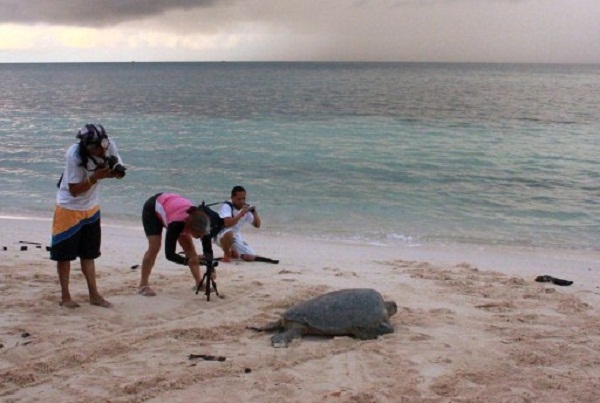Endangered turtle baby boom in Philippines

Conservation artist A.G. Saño (first from left), environmental filmmaker Carina Escudero and INQUIRER.net editor Dennis Atienza Maliwanag are taking photos and video of a green turtle making its way into the open sea after laying eggs on Baguan Island. AFP/Rina Bernabe/Conservation International
MANILA, Philippines—Globally endangered green turtles are enjoying a baby boom on remote Philippine islands as a three-decade protection program starts to pay off, environment group Conservation International said Wednesday.
The project is a key part of worldwide efforts to rebuild green turtle populations, and could help see the species’ status upgraded from endangered to vulnerable in a few years, CI Philippines’ executive director Romeo Trono said.
“We are seeing very stable increases in their populations around the world and… this is a very important contribution,” Trono told Agence France-Presse, referring to the Turtle Islands sanctuary that straddles the Philippine-Malaysia sea border.
On Baguan, one of the nine islands that make up the sanctuary, 1.44 million turtle eggs were laid last year, the highest number since records started in 1984, according to Conservation International.
With one percent of green turtles generally surviving until adulthood, last year’s baby boom will lead to roughly 13,000 green turtles living a long life as they swim the world’s oceans, the group said.
Trono said this population alone could be one of the biggest in the world, alongside groups of green turtles in Australia and Costa Rica where conservation efforts are also underway.
The success on Baguan is so important because green turtles can live up to 100 years, meaning the 2011 boom’s impacts will be felt into the 22nd century.
Trono said that, when he began work on the Philippine project in the early 1980s as an environment department staff member, the eggs and their nests were regularly being “wiped out”.
The eggs are considered a delicacy in some parts of Asia, and foreign fishermen as well as locals were poaching them.
The conservation efforts, which involve Philippine and Malaysian authorities as well as Conservation International, have seen strengthening law enforcement and volunteer community patrols to stop egg poaching.
The Philippine coast guard and navy are involved in helping to patrol the areas on their side of the border.
Amid so many reports of species being eradicated or becoming increasingly endangered around the world, Conservation International hailed the Turtle Islands’ project as a model for helping to protect biodiversity.
“The increasing nest numbers show that when turtles are protected on their nesting beaches and in the water for long enough, they will recover,” said Bryan Wallace, a marine scientist with Conservation International.